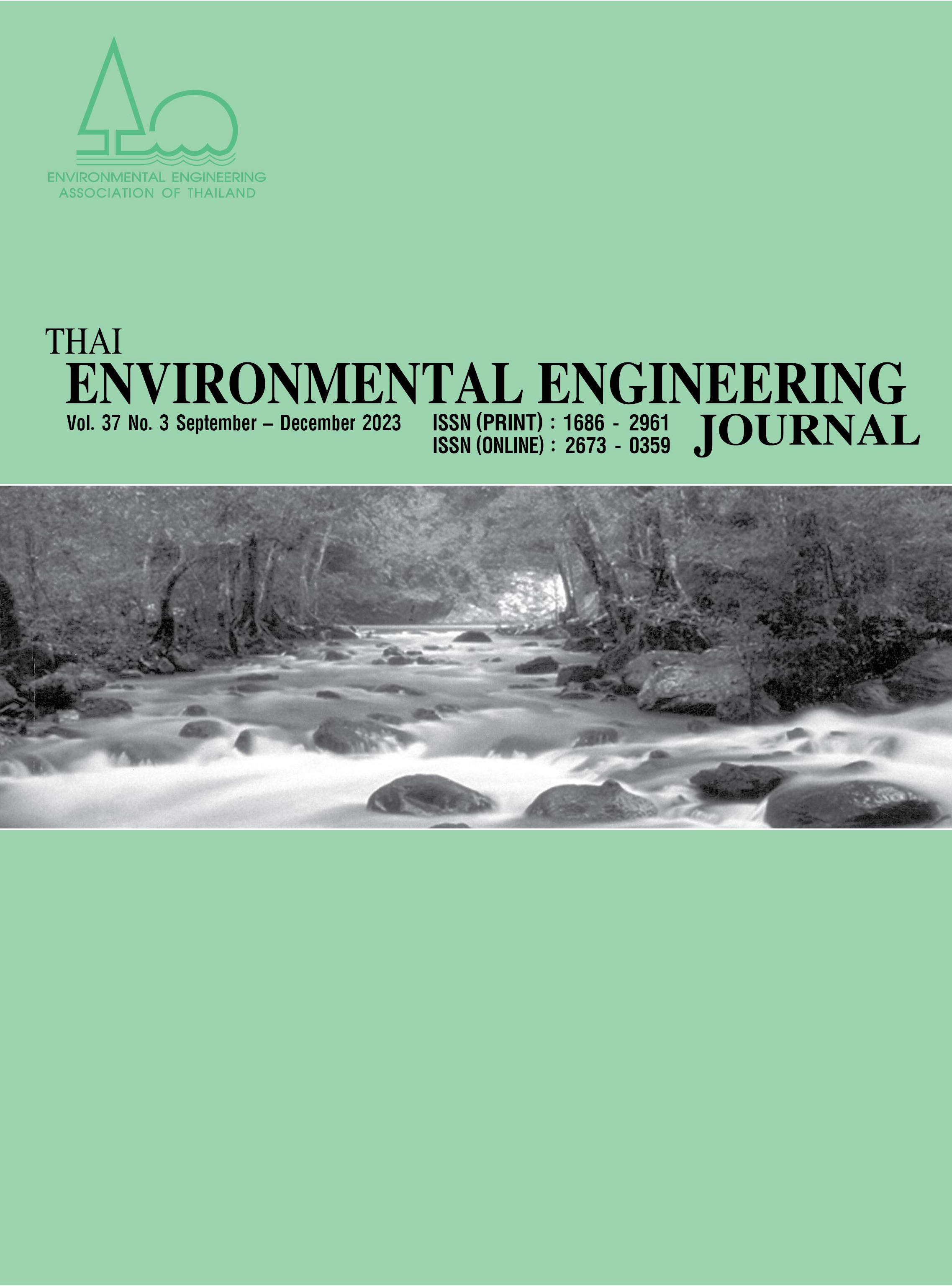Improving Indoor Air Quality: Utilizing Tropical Ornamental Plants for Carbon Dioxide Reduction
Main Article Content
Abstract
This study investigates types of ornamental plants for improve indoor air quality by specifically reducing CO2 levels. The fourteen plant types examined are Epipremnum aureum, Spathiphyllum sp., Nephrolepis Exaltata, Chlorophytum Comosum, Codiaeum Variegatum Blume, Epipremnum Aureum (Linden & André) G. S. Bunting, Crinum asiaticum, Dracaena trifasciata, Diffenbachia picta Schott, Portulacaria afra f. variegata, Peperomia obtusifolia (L.) F.Dietr, Aglaonema cochinchinense, Pilea Cadierei, and Cordyline fruticose (L.) A.Chev. The ability of each ornamental plant to reduce CO2 levels was recorded over a 24-hour period. It was observed that Epipremnum aureum exhibited superior CO2 absorption capabilities compared to other ornamental plants in this study. It had an average CO2 absorption and release of -36 and 2 ppm, respectively, in the closed chamber, both during the daytime and nighttime. It is suggested to incorporate these plants in various living areas such as the living room, kitchen, bedroom, or office spaces.
Article Details
References
Satish, U., Mendell, M. J., Shekhar, K., Hotchi, T., Sullivan, D., Streufert, S. and Fisk, W. J. 2012. Is CO2 an Indoor Pollutant? Direct Effects of Low-to-Moderate CO2 Concentrations on Human Decision-Making Performance. Environmental Health Perspectives. 120(12): 1671-1677.
Atarodi, Z., Karimyan, K., Gupta, V.K., Abbasi, M. and Moradi. M. 2018. Evaluation of and Indoor Air Quality and Its Symptoms in Office Building – A Case Study of Mashhad, Iran. Data in Brief. 20: 74-79.
Sinha, A., Thakkar, H., Rezaei, F., Kawajiri, Y. and Realff, M. J. 2018. Direct Air Capture of CO2 in Enclosed Environments: Design under Uncertainty and Techno-Economic Analysis. Computer Aided Chemical Engineering. 44: 2179-2184.
Pettit, T., Irga, P.J. and Torpy, F.R. 2018. Towards Practical Indoor Air Phytoremediation: A review. Chemosphere. 208: 960-974.
ASHRAE Standard 62.1. 2007. Ventilation for Acceptable Indoor Air Quality. American Society of Heating, Refrigerating and Air-Conditioning Engineers. Atlanta GA.
Taheri, S. and Razban, A. 2021. Learning-based CO2 Concentration Prediction: Application to Indoor Air Quality Control Using Demand-Controlled Ventilation. Building and Environment. 205: 108164.
Smith, A. and Pitt, M. 2011. Healthy workplaces: Plantscaping for Indoor Environmental Quality. Facilities. 29(3/4): 169-187.
Su, Y.M. and Lin, C. 2015. Removal of Indoor Carbon Dioxide and Formaldehyde Using Green Walls by Bird Nest Fern. The Horticulture Journal. 84(1): 69-76.
Brilli, F., Fares, S., Ghirardo, A., Visser, P.d. Calatayud, V., Muñoz, A., Annesi-Maesano, I., Sebastiani, F., Alivernini, A., Varriale, V. and Menghini, F. 2018. Plants for Sustainable Improvement of Indoor Air Quality. Trends in Plant Science. 23(6): 507-512.
Yarn, K.F., Yu, K.C., Huang, J.M., Luo, W.J, and Wu, P.C. 2013. Utilizing a Vertical Garden to Reduce Indoor Carbon Dioxide in An Indoor Environment. Wulfenia. 20(10): 180-194.
Husti, A., Cantor, M., Stefan, R., Miclean, M., Roman, M., Neacsu, I., Contiu, I., Magyari, K. and Baia, M. 2016. Assessing the Indoor Pollutants Effect on Ornamental Plants Leaves by FT-IR Spectroscopy. Acta Physica Polonica A. 129(1): 142-149.
Jamaludin, N.M., Mahyuddin, N. and Akashah, F.W. 2016. Assessment of Indoor Environmental Quality (IEQ): Students Well-Being in University Classroom with the Application of Landscaping. MATEC Web of Conferences. The 4th International Building Control Conference. 66: 00061.
Torpy, F.R., Zavattaro, M. and Irga, P. 2017. Green wall Technology for The Phytoremediation of Indoor Air: A System for The Reduction of High CO2 Concentrations. Air Quality Atmosphere and Health. 10(5): 575-585.
Torpy, F.R., Irga, P.J. and Burchett, M.D. 2014. Profiling Indoor Plants for The Amelioration of High CO2 Concentrations. Urban Forestry & Urban Greening. 13(2): 227-233.
Plitsiri, I. and Taemthong, W. 2022. Indoor Carbon Dioxide Reduction by Ornamental Plants: Comparison between Natural and Artificial Daylight. International Transaction Journal of Engineering, Management, & Applied Sciences & Technologies. 13(9): 1-12.
Yang, D.S., Pennisi, S.V., Son, K.C., and Kays, S.J. 2009. Screening Indoor Plants for Volatile Organic Pollutant Removal Efficiency. HortScience. 44(5): 1377-1381.
Sriprapat, W., Suksabye, P., Areephak, S., Klantup, P., Waraha, A., Sawattan, A. and Thiravetyan, P. 2014. Uptake of Toluene and Ethylbenzene by Plants: Removal of Volatile Indoor Air Contaminants. Ecotoxicology and Environmental Safety. 102: 147-151.
Taemthong, W. and Cheycharoen, N. 2022. Green Walls Can Improve Indoor Air. Proceedings of International Structural Engineering and Construction. 9(1): 1-7.
Weerasinghe, N.H., Silva, P.K., Jayasinghe, R.R., Abeyrathna, W.P., John, G.K.P. and Halwatura, R.U. 2023. Reducing CO2 Level in The Indoor Urban Built Environment: Analysing Indoor Plants under Different Light Levels. Cleaner Engineering and Technology. 14: 100645.
https://www.dhs.wisconsin.gov/chemical/carbondioxide.htm. (Accessed on 10 October 2023).
Ding, N., Liu, F., Ding, X., Yan, L. and Meng, X. 2022. Effect of Lighting Environment on The CO2 Concentration Reduction Efficiency of Plants by a Model Experiment. Buildings. 12(11): 1848.
Kumara, G.A.I.P., Beneragama, C.K., Mohotti, A.J., Chamara, R.M.S.R. and Kumara, G.D.K. 2018. Monitoring CO2 Emission and Absorption in Selected Indoor Plants to Combat Sick Building Syndrome. Proceedings of National Symposium on Floriculture Research. 24-32.
Koodkaew. I. Plant stress. https://biology.ipst.ac.th/?p=3361 (Accessed on 19 November 2023).
Shi. Y., Ke. X., Yang. X., Liu. Y. and Hou. X. 2022. Plants Response to Light Stress. Journal of Genetics and Genomics. 49(8): 735-747.
https://www.mars-hydro.com/info/post/the-light-stress-in-plants (Accessed on 19 November 2023).
Gubb, C., Blanusa, T., Griffiths, A. and Pfrang, C. 2018. Can Houseplants Improve Indoor Air Quality by Removing CO2 and Increasing Relative Humidity?. Air Quality Atmosphere & Health 11(10): 1191-1201.
Lee, J. and Kang, H. 2015. The Effect of Improving Indoor Air Quality using some C3 Plants and CAM Plants. Indian Journal of Science and Technology: 8(26): 1-7.
Andrews, T.J. and G.J. Muller. 1985. Photosynthetic Gas Exchange of Mangrove, Rhizophora stylosa Griff., in Its Natural Environment. Oecologia (Berlin). 65(3): 449-455.
Kramer, P.J. and T.T. Kozlowski. 1979. Physiology of Woody Plants. Academic Press, New York. 811 p.
Larcher, W. 1983. Physiological Plant Ecology. 2nd. Springer-Verlag, Berlin. 303.


